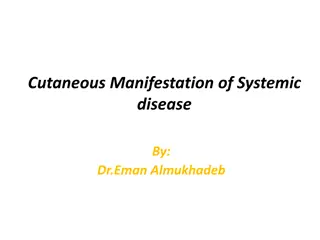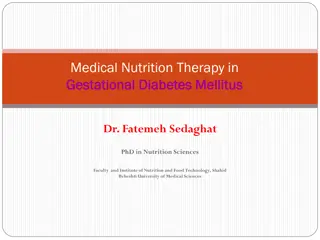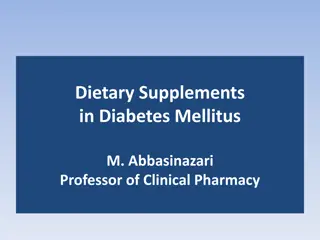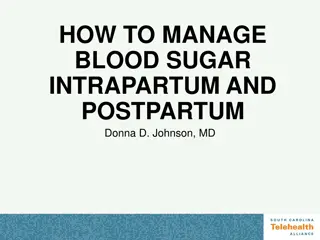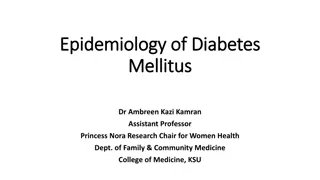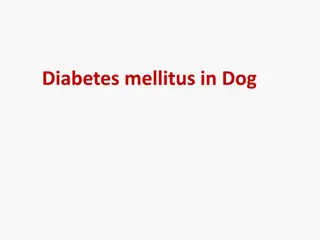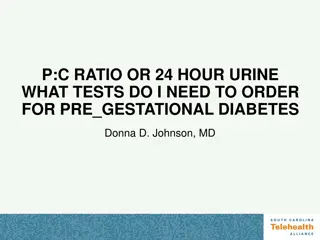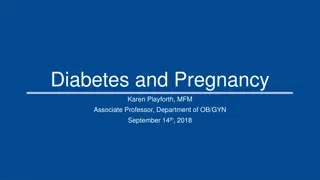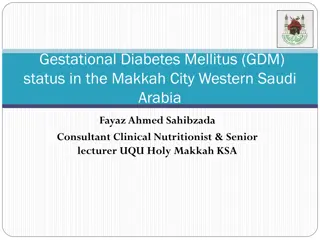
Gestational Diabetes Mellitus: Risk Factors, Detection, and Management
Gestational Diabetes Mellitus (GDM) is a condition diagnosed during pregnancy, distinct from type 1 and type 2 diabetes. This article explores the risk factors, including history of GDM and excessive weight gain, and emphasizes the importance of screening for early detection. Learn about the mechanisms behind GDM, how it differs from other types of diabetes, and the challenges in determining its exact prevalence.
Download Presentation

Please find below an Image/Link to download the presentation.
The content on the website is provided AS IS for your information and personal use only. It may not be sold, licensed, or shared on other websites without obtaining consent from the author. If you encounter any issues during the download, it is possible that the publisher has removed the file from their server.
You are allowed to download the files provided on this website for personal or commercial use, subject to the condition that they are used lawfully. All files are the property of their respective owners.
The content on the website is provided AS IS for your information and personal use only. It may not be sold, licensed, or shared on other websites without obtaining consent from the author.
E N D
Presentation Transcript
Gestational Diabetes Mellitus By Karen L. Whalen, Pharm.D., BCPS, CDE, FAPhA; and James R. Taylor, Pharm.D., BCACP, CDE
INTRODUCTION: In the past, any hyperglycemia initially detected during pregnancy was considered gestational diabetes mellitus (GDM), regardless of whether the condition actually existed before the pregnancy or continued after the pregnancy.
Today, GDM is diabetes that is diagnosed in the second or, more commonly, third trimester and is distinct from type 1 and type 2 diabetes. Diabetes developing during the first trimester is generally considered type 2 diabetes, although it can be type 1 . (ADA 2017a).
Because of variations in reporting, the population being studied, and the lack of universal diagnostic criteria, the exact prevalence of GDM is difficult to determine. A recent CDC report found prevalence rates of 4.6% and 9.2%, depending on the data sources used .
A history of GDM is the most significant risk factor for GDM. Other risk factors include Asian, Native American, Pacific Islander, African American, or Hispanic ethnicity; BMI of 25 kg/m2 or greater; diabetes in a first-degree relative;
Excessive early gestational weight gain (first-trimester weight gain of 2 kg plus second-trimester weight gain per week of 0.6 kg for underweight, 0.45 kg for normal weight, 0.32 kg for overweight, and 0.27 kg for women with obesity); macrosomia in a previous pregnancy; maternal age older than 35; and weight gain of more than 5 kg since 18 years of age .
Women with GDM are often asymptomatic, so screening is important for detection. In a normal pregnancy, insulin resistance develops in the second trimester and continues until birth.
The mechanism is not fully understood but is believed to be related to the production of hormones, cytokines, or adipokines by the placenta. Insulin secretion also increases, resulting in normal glucose concentrations.
Gestational diabetes typically develops because of preexisting increased insulin resistance and diminished insulin secretion.
MATERNAL AND FETAL COMPLICATIONS
Maternal Complications Potential maternal complications associated with GDM include gestational hypertension, preeclampsia, and non-elective cesarean delivery.
Regarding long-term complications, up to 50% of women with GDM will develop type 2 diabetes later in life. On average, this occurs 22 28 years after pregnancy . Ethnicity and obesity (BMI > 30 kg/m2) may play a role in the risk and timing of the subsequent diagnosis of diabetes.
Fetal Complications: Neonates of women with GDM are at increased risk of macrosomia, which is defined as a birth weight over 4000 g, as well as neonatal hypoglycemia, hyperbilirubinemia, birth trauma, respiratory distress syndrome, and shoulder dystocia .
Macrosomia is the most common fetal complication, with a reported incidence of 15% 45%, followed by hyperbilirubinemia in 10% 13% of neonates .
Hypoglycemia can occur in 3%5% of infants as a result of increased fetal insulin production in response to maternal hyperglycemia, which can increase the risk of seizures. Shoulder dystocia is a rare, but serious complication that can lead to brachial plexus injury.
Long-term complications of infants born to mothers with GDM include increased risk of impaired glucose tolerance, type 2 diabetes, hypertension, obesity, and dyslipidemia .
Benefits of Treatment : Few well-designed studies have evaluated the benefit of treating GDM. Trials to date have included treatment strategies of self-monitoring blood glucose, medical nutrition therapy, and insulin. Outcomes data using other treatment modalities are lacking.
Treatment of GDM reduces the risk of maternal hypertensive disorders by 40% . Rates of cesarean delivery are unaffected by treatment. Evidence on maternal long-term complications, such as type 2 diabetes and obesity, is lacking.
A meta-analysis of five randomized clinical trials found that treating GDM results in a 50% reduction in risk of macrosomia in infants, although the absolute mean difference in birth weight was less than 150 g (Hartling 2013).
Risk of shoulder dystocia was reduced by 60%, although the overall events were rare (Hartling 2013). No difference was found for neonatal hypoglycemia, birth injury, or risk of eventually developing glucose intolerance.
Patient Care Scenario : A 34-year-old Hispanic woman at 30 weeks gestation in her first pregnancy presents for a follow-up visit. She was given a diagnosis of GDM at 28 weeks gestation, and her fasting glucose at diagnosis was 107 mg/dL. At that time, she was counseled to begin nutritional therapy and a moderate exercise regimen. Given the following glucose values over the past week, what is the best option for GDM management in this patient? Fasting glucose (mg/dL): 94, 102, 98, 97, 100, 93, 107 One hour after breakfast: 137, 140, 142, 135 One hour after lunch: 132, 141, 148 Two hours after dinner: 129, 120, 118, 124
SCREENING AND DIAGNOSIS OF GDM: Women who are at risk of preexisting diabetes should be screened at their first prenatal visit using the diagnostic criteria for nonpregnant adults.
This includes overweight women or women with obesity with at least one additional risk factor, such as physical inactivity, family history of diabetes, hig hrisk ethnicity, history of GDM, hypertension, or hyperlipidemia
Screening Methods Screening and diagnosis of GDM may consist of either a one or a two-step approach .
The one-step approach was initially recommended by the ADA in 2011 for use in all pregnant women without preexisting diabetes. It involves a 75-g OGTT at 24 28 weeks gestation.
The two-step approach has been recommended by ACOG and an NIH consensus development program (ACOG 2013).
Controversies Regarding Best Screening Method : The IADPSG and ADA recognize that using the one- step approach would likely increase the number of women with a GDM diagnosis because only one abnormal value is needed for diagnosis. Although this may lead to increased health care costs, the ADA believes that the benefits outweigh these disadvantages. International Association of Diabetes and Pregnancy Study Group (IADPSG)
Data are unavailable from randomized controlled trials regarding outcomes for these additional women whose GDM would be diagnosed by the one- step method.
In the two-step approach, two different sets of glucose thresholds exist: Carpenter-Coustan and National Diabetes Data Group (NDDG).
The Carpenter-Coustan thresholds are lower than the NDDG thresholds, resulting in higher rates of GDM diagnoses. Use of the Carpenter-Coustan criteria increases diagnosis by 30% 50% (Gokcel 2002; Magee 1993).
Comparative trials are limited, making it difficult to recommend one criteria over another. Clinicians and institutions should select one criteria to use consistently, with local rates of diabetes and availability of resources for managing GDM factored into that decision.
The authors concluded that higher glucose thresholds did not consistently have higher maternal or fetal risks, and further research is needed to determine which diagnostic criteria are associated with the best outcomes.
MONITORING IN GDM: Blood Glucose Monitoring Once a woman has a diagnosis of GDM, routine glucose monitoring should begin. Evidence is lacking regarding the optimal frequency of testing, but the general recommendation is to monitor four times a day .
This would consist of daily monitoring of fasting glucose and 1 or 2 hours after each meal. Data are insufficient regarding whether 1- versus 2-hour postprandial monitoring is superior.
Postprandial glucose control is associated with better overall glycemic control and may be more predictive of maternal and fetal complications. Individuals with GDM that is diet controlled can monitor less often.
Glucose Goals and Other Monitoring Values: Observational studies show that A1C concentrations less than 6% 6.5% are associated with the lowest rates of fetal complications, but trials have not evaluated the risk-benefit of achieving these targets.
Hemoglobin A1C concentrations during normal pregnancy fall by as much as 0.5% because of increased RBC turnover . Furthermore, because postprandial glucose is a better indicator of risk of complications, A1C is not as useful.
NONPHARMACOLOGIC MANAGEMENT
Nutritional Therapy: Medical nutrition therapy is the cornerstone of treatment for GDM . Dietary intervention, in combination with insulin therapy as needed, reduces the risk of LGA infants, fetal macrosomia, preeclampsia, and serious perinatal complications .
All women with GDM should receive dietary counseling at the time of diagnosis, preferably provided by a registered dietitian or nutritionist experienced in GDM management.
The goals of dietary modification in GDM are to attain the desired level of glycemic control; provide adequate weight gain, which contributes to maternal and fetal well-being; and prevent the development of ketosis .
Suggested weight gain during pregnancy for patients with GDM varies according to the pre-pregnancy BMI. The ADA recommends a weight gain of 6.8 11.3 kg for overweight women and 4.5 9.1 kg for women with obesity.
Excessive weight gain is associated with a greater risk of fetal macrosomia and should be avoided. Conversely, women who gained less weight than recommended had a greater risk of delivering a small- for-gestational-age infant.
More severe restriction of caloric intake may result in ketosis. Weight loss during pregnancy is not generally recommended . Weekly weight checks can be used to identify excessive or insufficient weight gain.
Medical nutrition therapy for women with GDM should emphasize distribution of calories, with a focus on restriction of carbohydrates.



